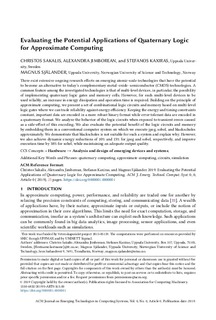Evaluating the Potential Applications of Quaternary Logic for Approximate Computing
Journal article
Accepted version

Åpne
Permanent lenke
http://hdl.handle.net/11250/2644541Utgivelsesdato
2019Metadata
Vis full innførselSamlinger
Originalversjon
10.1145/3359620Sammendrag
There exist extensive ongoing research efforts on emerging atomic-scale technologies that have the potential to become an alternative to today’s complementary metal--oxide--semiconductor technologies. A common feature among the investigated technologies is that of multi-level devices, particularly the possibility of implementing quaternary logic gates and memory cells. However, for such multi-level devices to be used reliably, an increase in energy dissipation and operation time is required. Building on the principle of approximate computing, we present a set of combinational logic circuits and memory based on multi-level logic gates in which we can trade reliability against energy efficiency. Keeping the energy and timing constraints constant, important data are encoded in a more robust binary format while error-tolerant data are encoded in a quaternary format. We analyze the behavior of the logic circuits when exposed to transient errors caused as a side effect of this encoding. We also evaluate the potential benefit of the logic circuits and memory by embedding them in a conventional computer system on which we execute jpeg, sobel, and blackscholes approximately. We demonstrate that blackscholes is not suitable for such a system and explain why. However, we also achieve dynamic energy reductions of 10% and 13% for jpeg and sobel, respectively, and improve execution time by 38% for sobel, while maintaining adequate output quality.